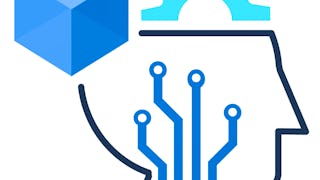This course introduces the concepts of Artificial Intelligence and Machine learning. We'll discuss machine learning types and tasks, and machine learning algorithms. You'll explore Python as a popular programming language for machine learning solutions, including using some scientific ecosystem packages which will help you implement machine learning.


Developing AI Applications on Azure

Instructor: Ronald J. Daskevich, DCS
48,724 already enrolled
Included with
(978 reviews)
Recommended experience
What you'll learn
Define Artificial Intelligence and Machine Language
Describe AI tools and roles, and the Microsoft Team Data Science Process
Work with Azure APIs, including those for vision, language, and search
Create, train, test and deploy your AI model in the cloud
Skills you'll gain
Details to know

Add to your LinkedIn profile
19 assignments
See how employees at top companies are mastering in-demand skills

There are 5 modules in this course
This module introduces Artificial Intelligence and Machine learning. Next, we talk about machine learning types and tasks. This leads into a discussion of machine learning algorithms. Finally we explore python as a popular language for machine learning solutions and share some scientific ecosystem packages which will help you implement machine learning. By the end of this unit you will be able to implement machine learning models in at least one of the available python machine learning libraries.
What's included
10 videos6 readings4 assignments1 discussion prompt
This module introduces machine learning tools available in Microsoft Azure. It then looks at standardized approaches developed to help data analytics projects to be successful. Finally, it gives you specific guidance on Microsoft's Team Data Science Approach to include roles and tasks involved with the process. The exercise at the end of this unit points you to Microsoft's documentation to implement this process in their DevOps solution if you don't have your own.
What's included
9 videos2 readings3 assignments1 discussion prompt
This module introduces you to Microsoft's pretrained and managed machine learning offered as REST API's in their suite of cognitive services. We specifically implement solutions using the computer vision api, the facial recognition api, and do sentiment analysis by calling the natural language service.
What's included
7 videos3 readings3 assignments1 discussion prompt
This module introduces you to the capabilities of the Azure Machine Learning Service. We explore how to create and then reference an ML workspace. We then talk about how to train a machine learning model using the Azure ML service. We talk about the purpose and role of experiments, runs, and models. Finally, we talk about Azure resources available to train your machine learning models with. Exercises in this unit include creating a workspace, building a compute target, and executing a training run using the Azure ML service.
What's included
7 videos3 readings5 assignments
This module covers how to connect to your workspace. Next, we discuss how the model registry works and how to register a trained model locally and from a workspace training run. In addition, we show you the steps to prepare a model for deployment including identifying dependencies, configuring a deployment target, building a container image. Finally, we deploy a trained model as a webservice and test it by sending JSON objects to the API.
What's included
8 videos1 reading4 assignments
Instructor

Offered by
Explore more from Machine Learning
 Status: Free Trial
Status: Free Trial Status: Free Trial
Status: Free TrialMicrosoft
 Status: Free Trial
Status: Free Trial Status: Free Trial
Status: Free Trial
Why people choose Coursera for their career




Learner reviews
978 reviews
- 5 stars
65.43%
- 4 stars
20.85%
- 3 stars
8.28%
- 2 stars
2.14%
- 1 star
3.27%
Showing 3 of 978
Reviewed on Jun 12, 2020
There can be a project submission session where we have hands on experience in using the API's and also ML experiments
Reviewed on Aug 12, 2020
It was a very good learning course. For a AI Azure beginner, it was very good. The instructors were superb !!!
Reviewed on May 28, 2020
Good since you can give quiz without watching videos if you want so it creates environment that how the videos are important to want.

Open new doors with Coursera Plus
Unlimited access to 10,000+ world-class courses, hands-on projects, and job-ready certificate programs - all included in your subscription
Advance your career with an online degree
Earn a degree from world-class universities - 100% online
Join over 3,400 global companies that choose Coursera for Business
Upskill your employees to excel in the digital economy
Frequently asked questions
To access the course materials, assignments and to earn a Certificate, you will need to purchase the Certificate experience when you enroll in a course. You can try a Free Trial instead, or apply for Financial Aid. The course may offer 'Full Course, No Certificate' instead. This option lets you see all course materials, submit required assessments, and get a final grade. This also means that you will not be able to purchase a Certificate experience.
When you enroll in the course, you get access to all of the courses in the Specialization, and you earn a certificate when you complete the work. Your electronic Certificate will be added to your Accomplishments page - from there, you can print your Certificate or add it to your LinkedIn profile.
Yes. In select learning programs, you can apply for financial aid or a scholarship if you can’t afford the enrollment fee. If fin aid or scholarship is available for your learning program selection, you’ll find a link to apply on the description page.
More questions
Financial aid available,

